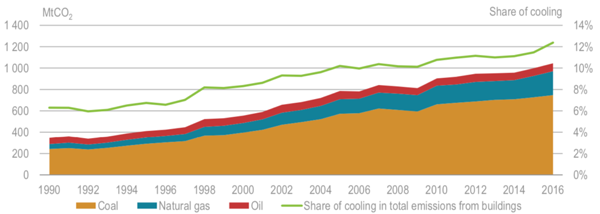How air conditioning is warming the planet
Today we'll be talking about air-conditioning, the different environmental impacts it has and what is being done to improve the situation.
The 1987 Montreal Protocol has been hailed as one of the most successful International treaties to ever have been ratified. With 46 signatories, this accord aimed to phase out the use of (hydro)chlorofluorocarbons, or (H)CFCs – anthropogenic compounds which had been released into the atmosphere since the 1930s by home appliances such as air-conditioning units and refrigerators. These compounds were found to be break up the stratospheric ozone layer, which plays a crucial role in shielding the Earth’s surface from harmful UV-radiation. The success of the treaty was not only displayed in getting all those signatories, but also in that it actually reached the environmental goal that it set out to achieve.
So, the treaty was successful and we were saved from environmental disasters, right? Well, not quite. Countries did ban the use of (H)CFCs and the ozone hole has not grown in size in the past 20 years, however, it became apparent that ACs have environmental impacts.
You may wonder what could possibly be so damaging about air conditioning units. After all, they don’t seem to emit smoke or harmful radiation. ACs can have environmental impacts in two different ways: leaking cooling agents and influence of energy-related emissions. The units themselves only emit greenhouse gases (GHGs), when leakage or improper disposal of the cooling agent occurs. HFCs (hydrofluorocarbons) have been the refrigerant of choice after the ban on ozone depleting agents, which do not affect the stratospheric ozone layer, but are extremely powerful GHGs, with a global warming potential of up to 100-3000 times higher than that of CO2. If leaked or improperly disposed of, then they can remain in the environment for up to hundreds of years due to their high stability.
The main environmental impact, however, is energy related. Globally, the environmental impacts of energy generation are alarming. In 2016, for the world as a whole, fossil fuels accounted for 65% of total energy generation. The share of space cooling in total energy-related CO2 emissions in buildings, mainly caused by coal burning in power stations, doubled between 1990 and 2016 (Figure 1). Global energy demand for ACs is expected to triple by 2050 and their use in homes and offices will be one of the top drivers of global electricity demand.
Figure 1. World CO2 emissions associated with space cooling energy use by source (Source: IEA, 2018)
And so, we have arrived at the essence of the problem – supplying power to these ACs comes with large costs and environmental implications. This also means that we are dealing with a devilish negative feedback loop: as the temperatures get hotter, we begin to use more air conditioning, which in turn causes the temperatures to rise even higher. Rinse and repeat. Polar ice caps melt, Siberian permafrost melts and an inescapable global catastrophe ensues.
Hold on.
Things are not that bad and fortunately we are not stuck in this downward spiral with no way out.
So, what can be done?
Investing in more efficient ACs could cut future energy demand in half, as an International Energy Agency (IEA) report states. Through stringent minimum energy performance standards and other methods, such as labelling, the average energy efficiency of basic AC units could double by 2050. This is also an important development for the electrical grid, since more efficient ACs can reduce the need for new power plants to meet peak power demand during very hot periods. Solar energy comes into play as well, since the profile of electricity demand for space cooling generally matches (to some degree) that of solar PV output, which can help lower the cost of meeting peak load.
Energy spent on cooling of buildings is expected to triple in the next thirty years. Instead of trying to deny people access to air-conditioning, more efficient cooling technologies with cleaner refrigerants are being developed. The Kigali Cooling Efficiency Program, which works with international partners to phase out HFCs and support the transition to more efficient cooling equipment will play a significant role in the development of more energy-efficient technologies. By making air conditioning more efficient, it will become more affordable, secure and sustainable - leading to savings in investments, fuel and operating costs.
But while these developments are taking place, there is one simple thing that we can all do that does not involve technology and worldwide policy changes: use less of it.
If this article left you thirsty for more information about the future of air conditioning then I recommend you take a look at the IEA report: https://www.iea.org/newsroom/news/2018/may/air-conditioning-use-emerges-as-one-of-the-key-drivers-of-global-electricity-dema.html
You can also check out 15
sustainable tips provided by green companies on keeping your house cool on the following link:
https://www.redfin.com/blog/eco-friendly-ways-to-keep-your-house-cool/
References:
https://www.e-education.psu.edu/rocco/node/2034
https://apps.sepa.org.uk/spripa/Pages/SubstanceInformation.aspx?pid=121
https://www.bostonglobe.com/ideas/2013/07/20/how-live-without-air-conditioning/4DqSdLtDiJ4iAn29lNCjaI/story.html
https://webstore.iea.org/the-future-of-cooling
 lines
lines 
